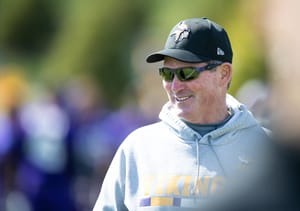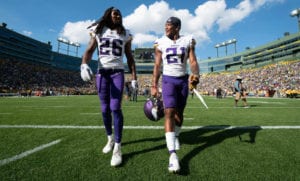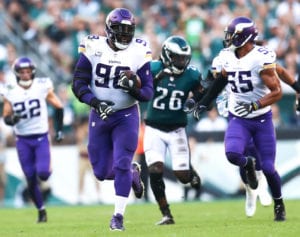Zimmer Wins by Continually Re-Investing in his Defense

Since 2015, several NFL teams have come and gone from consideration as the league’s best defense. The best scoring defense in the league that year, the Seattle Seahawks, had dropped out of the league’s best twelve just two years later. Similarly, the Cincinnati Bengals finished as the league’s second best scoring defense in 2015, with 279 points allowed. Two years later, the Bengals had regressed to a league average defense with 349 points allowed. The Denver Broncos had an elite top five defense in 2015 and 2016, but became one of the league’s worst defenses in 2017, when they ranked 24th in the NFL. Countless more examples can be found. While elite NFL offenses generally stay powerful from year to year, top NFL defenses are very vulnerable to regression and mediocrity.
Over the past four years, only a single NFL team has been one of the league’s best nine scoring defenses every season. This team has fought off regression, has remained elite, and has never had a league-average or worse seasonal performance. That team is the Minnesota Vikings, led by head coach Mike Zimmer.
How?
Unlike the other teams mentioned, Zimmer has been relentless in adding pieces to his defense. Instead of sticking with the same players and hoping for a similar performance, the Vikings continuously improve their defense every year. Zimmer’s first draft pick came in 2014, selecting Anthony Barr ninth overall. In the 2015 NFL Draft, Minnesota triple-dipped on defense. They added cornerback Trae Waynes, linebacker Eric Kendricks, and edge rusher Danielle Hunter, all of whom are still in starting roles going into the 2019 season. The next year they added cornerback Mackensie Alexander in the second round. In 2018, they also added cornerback Mike Hughes in the first round and cornerback Holton Hill as an undrafted free agent.
One remarkable note is how corner-heavy these drafts have been. Waynes, Alexander, Hughes, and Hill have all joined the Vikings in recent years – all are still on their rookie contracts. Also notable is how often these starters come from selections in the first few days of the draft. The strength of Mike Zimmer’s coaching is not the development of undervalued prospects into league stars. Kendall James, Brandon Watts, B.J. Dubose, Elijah Lee, and Jack Tocho are some of the defensive players drafted by the Vikings on day three of the NFL Draft who didn’t do much. Outside of rare exceptions like Stephen Weatherly or Jayron Kearse, these picks don’t turn into anything but backup or roster bubble players, but that’s what you would expect from low-cost draft picks.
Instead, Zimmer has the remarkable ability to take highly valued draft picks and convert them into quality players on defense. This seems like an obvious goal, but it is a task that many teams fail.

Trae Waynes (26) and Mike Hughes (21) walk off the field after a regular season tie in Green Bay. Both cornerbacks were selected in the First Round of the NFL Draft during Mike Zimmer’s head coaching tenure.
Defensive Drafts: Zimmer Thrives while the League Disappoints
In the 2016 NFL Draft, the New York Giants invested the tenth overall pick in Eli Apple, hoping to make him their long term star at cornerback. After a few disappointing seasons where teammates called him a cancer to the team and a suspension for fighting with the coaching staff, he was traded to the Saints for a fourth round pick. Bust.
On the same day as the Apple selection, the Oakland Raiders selected defensive back Karl Joseph fourteenth overall. Among all NFL Safeties, Pro Football Focus ranked Joseph 50th his rookie season, 35th in 2017, and 23rd in 2018. Just last week, the Raiders declined Joseph’s fifth-year option, meaning he will be a free agent after this season. Hardly the star player you expect to receive with a top fifteen draft pick investment. The same is true for first-rounder Artie Burns, another defensive back who will be off his team after this season after his option was declined. Both are busts for the teams that drafted them.
Yet in this very same draft, Mike Zimmer was able to land Mackensie Alexander in the second round. In his limited playing time, Alexander has certainly looked better than the higher picks spent on defensive backs like Eli Apple. A second round pick is still an investment, but with Zimmer it is a near guarantee that the investment pays off. There is no safer draft pick than a talented defensive back selected by Zimmer. Teams like the Giants and Raiders wish they hadn’t failed with their own first round selections.
The same story is true of other Vikings draft picks. Trae Waynes was the first cornerback off the board in the 2015 NFL Draft, and Zimmer made the right choice. The Vikings could have realistically grabbed Kevin Johnson or Marcus Peters as well, the next first-round cornerbacks of the board. Neither Johnson nor Peters is currently playing for the team that drafted them; Johnson was cut, Peters was traded for a fourth round and a future second round pick. Unlike the Giants in the previous example, the Vikings high pick turned out to be the best option. Converting draft capital into quality starters is harder than it looks, but the Minnesota Vikings routinely pull it off on defense.
Monetary Investment

Linval Joesph (98) signed with Minnesota in free agency after his rookie contract expired. He scored his first career touchdown with the Vikings in a regular season win over the Philadelphia Eagles.
The Vikings’ investment in their defense doesn’t end on draft day. The team has been willing to pay out big to keep defensive stars in house. Danielle Hunter, Xavier Rhodes, Harrison Smith, Eric Kendricks, and Anthony Barr have all signed long-term extensions with the Vikings to stay in Minnesota. In total, these five contracts will pay out $310,850,000. They are the core of the defense, and are paid handsomely for it.
They are also just as aggressive in Free Agency. Linval Joesph signed a lucrative contract with Minnesota to leave New York after his rookie contract expired. He has played well, and also signed his own extension that will keep him on the roster until 2022. Just last year, the Vikings coupled Kirk Cousins with another splash-signing of Sheldon Richardson, who has since moved onto Cleveland after proving his worth in Minnesota. Shamar Stephen was signed in free agency this year to replace him.
Since 2016, the Vikings have ranked in the top 12 teams in the league in terms of cap space dedicated to their defense. This year they rank second, as one of only three teams using over $100 million on the defensive side of the ball – along with the Browns and the Texans. Despite Cousins’ mega-deal and recent extensions to Stefon Diggs and Adam Thielen, the team spends more money on the defense than the offense. Minnesota also ranks third in 2020 cap space already allocated to the defense, and first in 2021 and 2022. Of course, this has to do with the amount of long-term deals they’ve given out, but it is still noteworthy. The main pieces on Minnesota’s defense is here to stay.
Concerns
This manner of roster construction is proving unsustainable. The Vikings are currently right up against the cap, due in part to the amount of money given to their stars like Anthony Barr. As such, the Vikings are limited in their ability to sign defensive free agents. Shamar Stephen was the only addition the Vikings made to their defense in 2019, himself a cheaper alternative to Sheldon Richardson on the defensive line. Of course, a functioning NFL defense needs more than a few star players at the top. The Vikings need to have the ability to start cheaper supporting players and build quality depth in case of injuries.
Utilizing the Draft is a great way to accomplish these goals. High round rookie draft picks can start in complementary roles and mid-round picks can compete for jobs as a second-string players, coming into a game when needed. For the most part, this is how Zimmer has prevented defensive regression that is common around the league. Investing heavily in defense in the draft allows the team to fill out needs cheaply, and to replace aging talent with younger players.
But in the 2019 draft this strategy was largely forgotten. The Vikings first four picks were spent on offense, and several late rounders were spent on positions like wide receiver and long snapper. Rookies like Cameron Smith or Marcus Epps may have to see playing time, ready or not, if injuries hit the Vikings hard this year. The team also has little remaining cap space to sign players on expiring contracts like Trae Waynes, Mackensie Alexander, or Anthony Harris. Again, there were no picks spent on rookies who could potentially replace these players in year two.
The Vikings have had a strategy to prevent defensive regression – invest through the draft, reinvest in home-grown talent, and supplement with Free Agency spending. With this strategy, the Vikings have retained an era of elite defensive performances. But starting this year, Minnesota has pulled back from that strategy, and the team may pay the price in future seasons.
